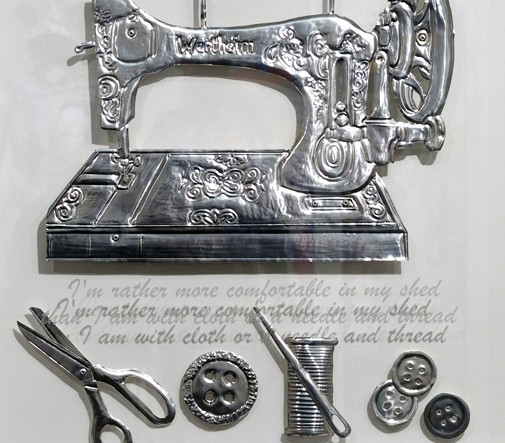Sun 01 March 2009 – Sun 22 March 2009
Location: Prospect Gallery, Nailsworth, South Australia
Bookings are no longer available.
Revealing Meaning in Cloth opened Sunday, 1 March 2009, at Prospect Gallery, Nailsworth, South Australia. Independent curator Vivonne Thwaites gave the opening speech to a full house, where she congratulated the participating artists for presenting their highly developed ideas and skills within the context of the textile arts.
The exhibition was presented as part of Prospect Gallery’s third Design Biennial and the 2009 Adelaide Fringe Festival,and it won the Fringe award for Best Exhibition by a Collective. Guest curator Annabelle Collett selected contemporary textile works by Craftsouth members Antonia Chaffey, Sandy Elverd, Helen Fuller, Karen Genoff, Agnieszka Golda, Rosie Hannam, Elene Kontonikas, Ann Newmarch, Julie Pieda, Mark Thomson, Julie Walker and Sera Waters.
Art works developed for this exhibition reveal how textile practices have broadened to embrace conceptual concerns using experimental approaches. In her catalogue essay, Collett explains that Revealing Meaning in Cloth is an ‘exploration of meaning within the textile arts and its application within contemporary practices. The medium of cloth facilitates an endless range of expression and is situated within the broader contexts of material and visual culture. Textiles and cloth have always functioned as carriers of meaning, as indicators of identity, history and culture.
In contemporary visual culture, artists have been known to use fabric extensively and without concern for the conceived boundaries between craft and fine art or the restricted notion of “textiles”, but rather they utilise the medium in multiple ways, in terms of form and content. A contemporary visual culture supports the use of hybrid materials and mixed processes, allowing for fresh interpretations with outcomes often going way beyond traditional practices.’
Collett goes on to say that ‘the medium of fabric provides a vast array of cultural references and material applications, with artists readily tapping into this store. The processes and methods that give substance to cloth are informed by a rich history. The conventional techniques of weaving, sewing, stitching, knitting and embellishing are increasingly being repositioned and incorporated within the expression of contemporary concerns and narratives.
‘There are significant haptic qualities to textiles. Most textile works are made through touch—the artist feels the material as they work. It’s an intimacy where hands are implicit in the making; easing a shape, defining a finish or manipulating a fold. Pressure and tension make hands the regulators when performing the task.
‘Sometimes the artist’s hands are employed in wilfully mismatching process with materials. Consider the traditional medium of embroidery and its connotations of domesticity, comfort and familiarity. In contemporary terms, embroidery is not only employed as a decorative device, artists also substitute traditional motifs, introducing entirely different and untraditional information and images as diversified mark making. Other artists reclaim textiles, transcending the item’s original function whilst maintaining the appeal of recognition. Attentive to the inherent properties of material, many textile artists seek to celebrate, transcend, reinvigorate, subvert, mimic and adorn cloth. Textiles thus become imbued with feeling, encapsulating many emotions, facilitating a vast range of expression to bring meaningful paradigms and ideas into the arena of the visual arts.’
As a textile artist, Collett perceives fabric as ‘the most exciting medium used in visual art practice. Having such broad references and varied applications, textiles have the ability to communicate to many audiences. Associations with cloth offer an immediate and often personal connection to making, wearing and dwelling; yet hopefully stimulate a ‘thinking’ about the meaning of fabric.
‘Audiences were encouraged to look for a deeper layer within the works featured in the exhibition, to experience a more intimate appreciation whilst drawing upon their own remembered associations with fabrics in various forms—adding significance to the broad scope of textile usage within contemporary creative practice.’

